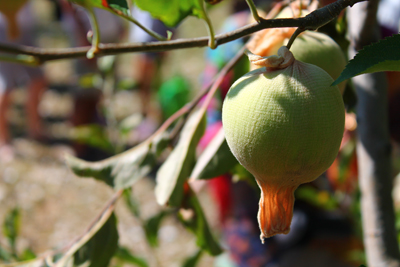
This might look like an exotic fruit, but it’s really just an apple in a stocking. Why? The volunteers who maintain this orchard try to avoid pesticides, so they put nylon socks over the apples when they are small to protect them from pests. The apples grow just fine inside the stocking, which can be removed at harvest time.

Susan, one of the coordinators of the community orchard, introduced us to two small pawpaw trees (Asimina triloba). Related to the custard-apple, pawpaw fruit is creamy and sweet. They are also native to eastern North America, and in Toronto we are at the northern edge of their range. While some trees can pollinate with trees of a different type and others can self-pollinate, pawpaws need to cross-pollinate with other pawpaws in order to produce fruit - so you’ll need to plant two if you want to enjoy this tasty treat. Interested in bringing some diversity to your yard? Check out our Backyard Tree Planting Program and see what you can grow!
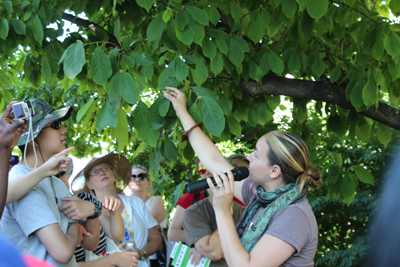
Did you know that magnolia (Magnolia spp.) buds are edible? Although they’d already flowered for this year, Amanda explained that they can be spicy like horseradish. But, she warned, only eat the buds right after they break free of the downy husk: like the other parts of the tree, they become unfortunately bitter after they bloom. I’m curious to try this next spring – but I’ll be careful not to steal too many of the beautiful flowers!
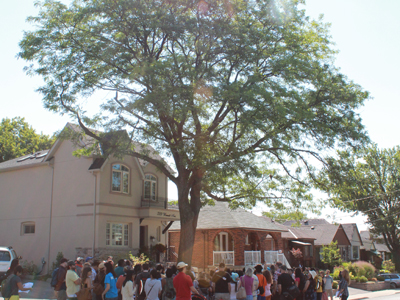
We stopped at a large honey locust (Gleditsia triacanthos), a common street tree in Toronto. Their fruit resembles large brown pods with big seeds inside, like tamarind or cacao. You can eat the gooey pulp which has a sweet, sugary taste (hence the name) - and some people even use it to make beer. However, many people aren’t fans of the mess the pods can leave when they fall, so we often plant non-fruiting varieties on our streets. Consider yourself lucky if you come across a fruiting one and don’t miss your chance to try it!
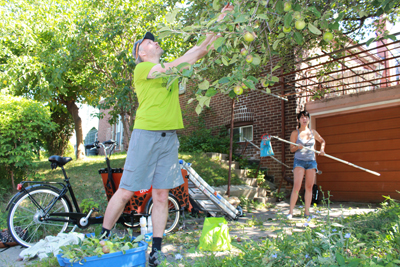
Next we stopped for a fruit pick with Not Far From The Tree volunteers. This program picks fruit from private trees and shares the harvest among the volunteers, the homeowner, and local food banks, shelters, and community kitchens. A volunteer demonstrated the use of an extendible pole with claws and a bag on the end, enabling him to easily pick high-up fruit without a ladder.
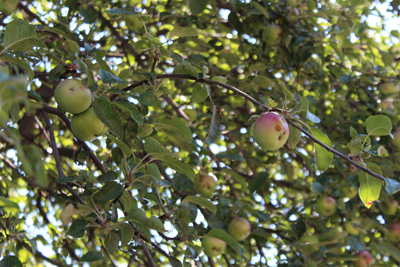
Becky told us that this apple tree has two different varieties of apples grafted onto a third variety of rootstock. They do this to get the benefits of strong and healthy roots as well as two kinds of tasty apples on one tree. Everyone on the tour got to pick an apple – yum!

We learned that juniper (Juniperus spp.) berries are edible as well. I’d known that juniper was used to flavor gin, but it turns out that you can make jelly out of the berries and that they can also be used as a spice: it’s particularly good in meat and cabbage dishes.
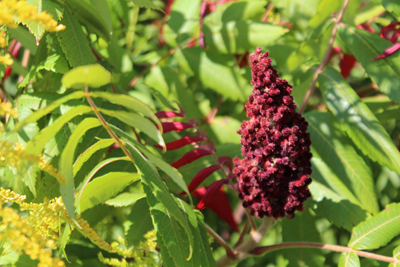
Staghorn sumac (Rhus typhina) gets its name from the fact that the branches look like fuzzy deer antlers. We learned that the neat-looking brilliant red cones are edible – they can be eaten as a trail snack, or steeped into an iced tea or pink lemonade. Amanda encouraged everyone to touch the cones and then taste our fingers to get a sense of the tangy flavour.

This European Mountain Ash (Sorbus aucuparia) is not technically an ash (Fraxinus spp.) at all, but a rose - so it’s not affected by the Emerald Ash Borer. Even better, the pretty orange berries are edible! You can pickle them or use in jellies. But be warned: they do taste bitter. Amanda suggested putting them in the freezer before using them to bring out the sugar.
All in all, it was a great way to spend a Saturday morning, exploring the urban forest and tasting its bounty as we went along. Will you join one of our next tours?
